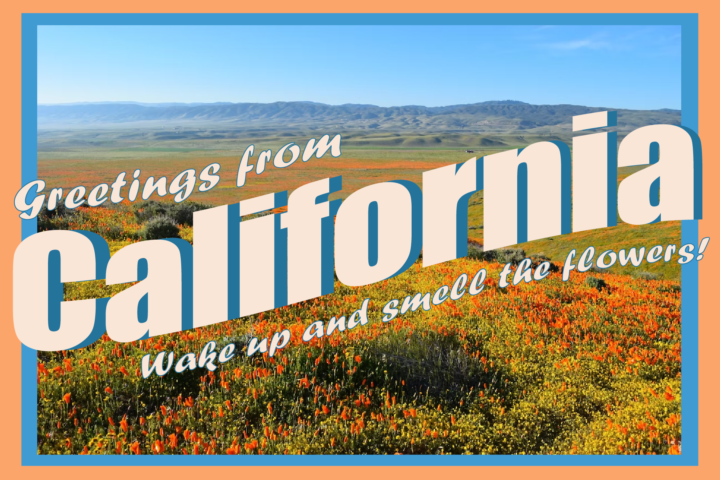Graphic by Elise Bechtel, photo from Unsplash
By Destiny Caster
Spring is in the air and so is pollen. A rare botanical phenomenon called a “super bloom” has taken over parts of California with wildflowers in hues of orange, yellow and purple. After multiple weeks of heavy rainstorms and flooding, California is expected to experience the super bloom from April until July with most of the blooms happening in May.
While flowers bloom up and down the coast of California, the super bloom has blanketed some of the driest places in the state. The last super bloom occurred in 2019 with millions of wildflowers covering hillsides.
California’s Department of Parks and Recreation has a website page with places to see the super bloom. The page lists four Northern California areas, specifically Bay Area, and seven Southern California areas to view the botanical phenomenon. It also contains a description of the best months to visit each area, as well as the variety of flowers and wildlife. Some of the locations recommended include:
- Chino Hills State Park: The best wildflower viewing experience takes place along Bane Road. Visitors can hike on Bane Ridge Trail to see canterburies and school bells, arroyo lupines and California poppies.
- Antelope Valley California Poppy Reserve: While the poppy reserve has already reached its peak with flowers blooming. Visitors have a few more weeks to view the vibrant colors of the California poppies, pink filarees and yellow goldfields. The Antelope Trail, North Loop and Kitanemuk Vista Point will provide the best view of the wildflowers.
- Sugarloaf Ridge State Park: April and May bring whispering bells, popcorn flowers, Diogenes’ lantern, blue dicks, lupines and California poppies. The park hours are 6 a.m.-10 p.m.
- Mount Tamalpais State Park: Visitors should come in April and May to get the fullest viewing experience of the blooming flowers. The flowers that populate the park include narrow leaf mule’s ear, lupine, Ithuriel’s spear, blue dicks, California poppy and Western blue-eyed grass. Park hours are from 7 a.m. to sunset.
To practice responsible viewing of the super bloom, visitors should respect the “Leave No Trace Principles.” These principles are in place to preserve the environment, not just for others to see, but to also ensure that we are not harming the other plants and animals in the ecosystem.
When visiting areas to view the super bloom, people should only walk on the official, marked trails and avoid lying, stepping or driving over wildflowers. Visitors should leave what they find, including rocks, plants and other natural objects. While taking aesthetic pictures for social media and collecting souvenirs is fun, people should be mindful that they are not the only ones that will be viewing the super bloom and be respectful of that.
Additionally, make sure to do research on what parks and reserves allow dogs in the bloom area. Pet waste takes longer to break down than wild animal waste and may contain bacteria that negatively affects the environment. Make sure to pick up after your animals in addition to any other waste to keep the parks clean and thriving.
Catch the super bloom before it goes away at any of the locations described on the California’s Department of Parks and Recreation website. Even experience the increased abundance in wildflowers at hiking trails near CI, like the Sycamore Canyon Trailhead. Remember to show respect and consideration for others and the environment to preserve this amazing natural phenomenon!

